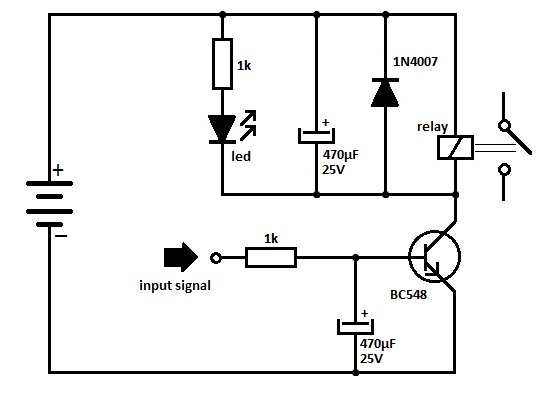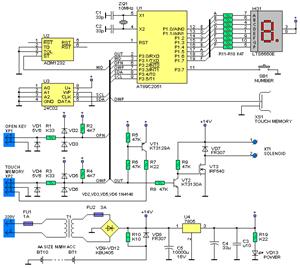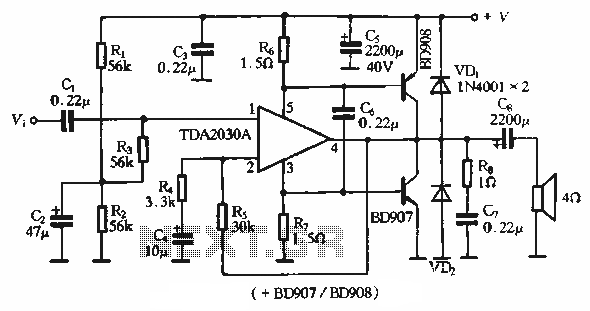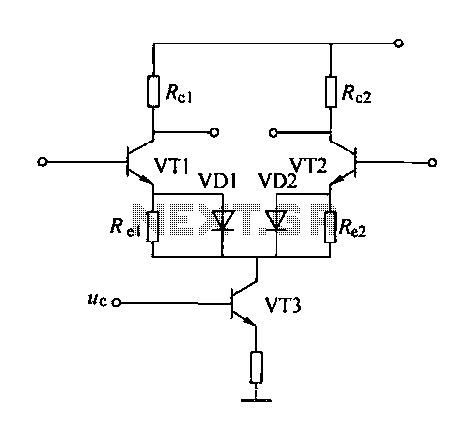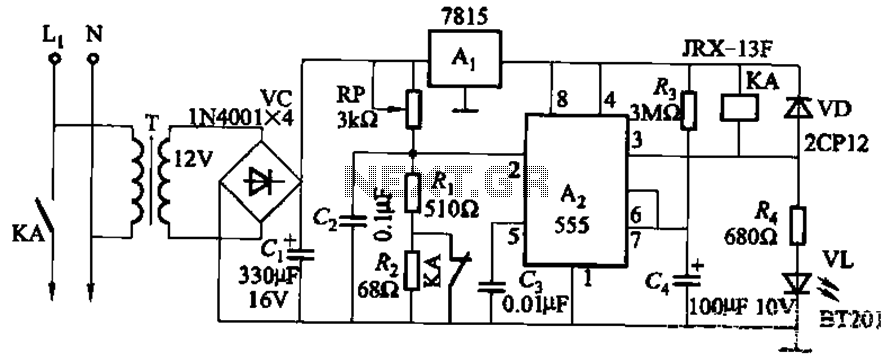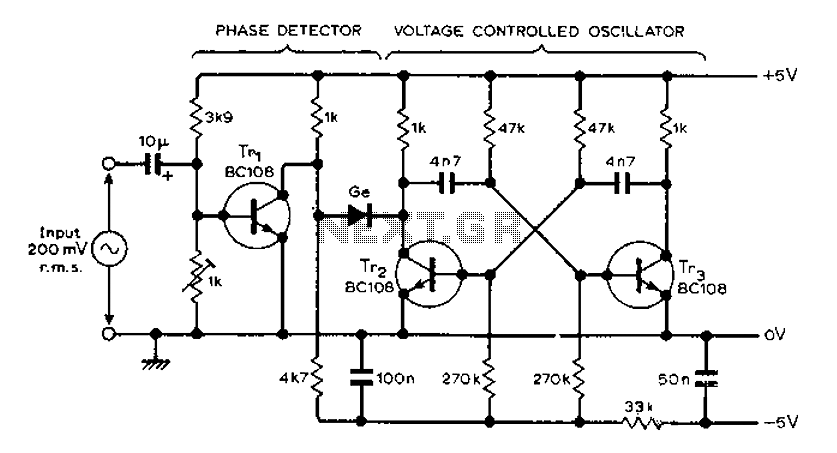
telephone sharer circuit 9

To utilize this facility, the calling subscriber must first dial the standard phone number of the intended recipient. Once the call is connected, the calling party does not hear a ring-back tone. The calling subscriber must then press the asterisk (*) button on the telephone to activate tone mode (if the phone is set to dial mode) and enter the extension number, for example, 1, within 10 seconds. If the calling subscriber fails to dial the required extension number within this time frame, the line will be automatically disconnected. Additionally, if the dialed extension phone is not answered within 10 seconds, the ring-back tone will stop. The ring signal on the main phone line is detected by opto-coupler MCT-2E (IC1), which activates a 10-second timer formed by IC2 (555) and energizes relay RL10 (6V, 100-ohm, 2 C/O). One of the normally open (N/O) contacts of the relay connects the +6V rail to the processing circuitry, while the other provides a 220-ohm loop resistance to deactivate the ringer relay in the telephone exchange, effectively cutting off the ring. When the caller dials the extension number (for instance, 1) in tone mode, the tone receiver CM8870 (IC3) outputs the code 0001, which is sent to the 4-bit BCD-to-10 line decimal decoder IC4 (CD4028). The output of IC4 at pin 14 (Q1) goes high, activating the SCR (TH-1) and the associated relay RL1. Relay RL1 connects, through its N/O contacts, the 50Hz extension ring signal derived from the 230V AC mains to the line of telephone 1. This ring signal is directed exclusively to telephone 1, as half of the signal is blocked by diode D1 and DIAC1 (which do not conduct below 35 volts). When phone 1 is lifted, the ring current increases, resulting in a voltage drop across resistor R28 (220-ohm, 1/2W) that activates opto-coupler IC5 (MCT-2E). This action resets timer IC2, causing...
The described circuit functions as an advanced call handling system that integrates both tone signaling and relay control to manage incoming calls to a specific extension. The initial dialing of the recipient's number establishes a connection without the usual ring-back tone, which is a unique feature allowing for a more seamless user experience. The requirement for the caller to enter an extension number within a specified time frame ensures that the system remains efficient and responsive.
The use of an opto-coupler (MCT-2E) for detecting the ring signal is critical for isolating the control logic from the high-voltage telephone line, enhancing safety and reliability. The 555 timer IC (IC2) is configured in a monostable mode to provide a precise timing mechanism, ensuring that the line is disconnected after 10 seconds if no extension is dialed. The relay (RL10) plays a dual role by providing power to the processing circuitry and disabling the ringer in the exchange, preventing unnecessary ringing.
Upon dialing the extension, the tone receiver (CM8870) accurately decodes the DTMF tones and communicates with the BCD-to-decimal decoder (CD4028), which simplifies the logic needed to control the relay (RL1). The SCR (TH-1) serves as an electronic switch that allows for the control of the 50Hz ring signal. The intentional blocking of half the signal through diode D1 and DIAC1 ensures that only the intended telephone receives the ring, preventing interference with other lines.
Overall, this circuit exemplifies a sophisticated approach to telephone extension management, utilizing common electronic components to create a functional and responsive system for call routing and handling. The careful design considerations, including timing, isolation, and signal processing, contribute to the reliability and effectiveness of the system in a telecommunications environment.For making use of this facility, the calling subscriber is required to initially dial the normal phone number of the called subscriber. When the call is established, no ring-back tone is heard by the calling party. The calling subscriber has then to press the asterik (*) button on the telephone to activate the tone mode (if the phone normally work
s in dial mode) and dial extension number, say, 1`, within 10 seconds. (In case the calling subscriber fails to dial the required extension number within 10 seconds, the line will be disconnected automatically. ) Also, if the dialed extension phone is not lifted within 10 seconds, the ring-back tone will cease.
The ring signal on the main phone line is detected by opto-coupler MCT- 2E (IC1), which in turn activates the 10-second on timer`, formed by IC2 (555), and energises relay RL10 (6V, 100- ohm, 2 C/O). One of the N/O` contacts of the relay has been used to connect +6V rail to the processing circuitry and the other has been used to provide 220-ohm loop resistance to de-energise the ringer relay in telephone exchange, to cut off the ring.
When the caller dials the extension number (say, 1`) in tone mode, tone receiver CM8870 (IC3) outputs code 0001`, which is fed to the 4- bit BCD-to-10 line decimal de- coder IC4 (CD4028). The output of IC4 at its output pin 14 (Q1) goes high and switches on the SCR (TH-1) and associated relay RL1.
Relay RL1, in turn, connects, via its N/O contacts, the 50Hz extension ring signal, derived from the 230V AC mains, to the line of telephone 1`. This ring signal is available to telephone 1` only, because half of the signal is blocked by diode D1 and DIAC1 (which do not conduct below 35 volts).
As soon as phone 1` is lifted, the ring current in- creases and voltage drop across R28 (220-ohm, 1/2W resistor) increases and operates opto-coupler IC5 (MCT-2E). This in turn resets timer IC2 causing: 🔗 External reference
The described circuit functions as an advanced call handling system that integrates both tone signaling and relay control to manage incoming calls to a specific extension. The initial dialing of the recipient's number establishes a connection without the usual ring-back tone, which is a unique feature allowing for a more seamless user experience. The requirement for the caller to enter an extension number within a specified time frame ensures that the system remains efficient and responsive.
The use of an opto-coupler (MCT-2E) for detecting the ring signal is critical for isolating the control logic from the high-voltage telephone line, enhancing safety and reliability. The 555 timer IC (IC2) is configured in a monostable mode to provide a precise timing mechanism, ensuring that the line is disconnected after 10 seconds if no extension is dialed. The relay (RL10) plays a dual role by providing power to the processing circuitry and disabling the ringer in the exchange, preventing unnecessary ringing.
Upon dialing the extension, the tone receiver (CM8870) accurately decodes the DTMF tones and communicates with the BCD-to-decimal decoder (CD4028), which simplifies the logic needed to control the relay (RL1). The SCR (TH-1) serves as an electronic switch that allows for the control of the 50Hz ring signal. The intentional blocking of half the signal through diode D1 and DIAC1 ensures that only the intended telephone receives the ring, preventing interference with other lines.
Overall, this circuit exemplifies a sophisticated approach to telephone extension management, utilizing common electronic components to create a functional and responsive system for call routing and handling. The careful design considerations, including timing, isolation, and signal processing, contribute to the reliability and effectiveness of the system in a telecommunications environment.For making use of this facility, the calling subscriber is required to initially dial the normal phone number of the called subscriber. When the call is established, no ring-back tone is heard by the calling party. The calling subscriber has then to press the asterik (*) button on the telephone to activate the tone mode (if the phone normally work
s in dial mode) and dial extension number, say, 1`, within 10 seconds. (In case the calling subscriber fails to dial the required extension number within 10 seconds, the line will be disconnected automatically. ) Also, if the dialed extension phone is not lifted within 10 seconds, the ring-back tone will cease.
The ring signal on the main phone line is detected by opto-coupler MCT- 2E (IC1), which in turn activates the 10-second on timer`, formed by IC2 (555), and energises relay RL10 (6V, 100- ohm, 2 C/O). One of the N/O` contacts of the relay has been used to connect +6V rail to the processing circuitry and the other has been used to provide 220-ohm loop resistance to de-energise the ringer relay in telephone exchange, to cut off the ring.
When the caller dials the extension number (say, 1`) in tone mode, tone receiver CM8870 (IC3) outputs code 0001`, which is fed to the 4- bit BCD-to-10 line decimal de- coder IC4 (CD4028). The output of IC4 at its output pin 14 (Q1) goes high and switches on the SCR (TH-1) and associated relay RL1.
Relay RL1, in turn, connects, via its N/O contacts, the 50Hz extension ring signal, derived from the 230V AC mains, to the line of telephone 1`. This ring signal is available to telephone 1` only, because half of the signal is blocked by diode D1 and DIAC1 (which do not conduct below 35 volts).
As soon as phone 1` is lifted, the ring current in- creases and voltage drop across R28 (220-ohm, 1/2W resistor) increases and operates opto-coupler IC5 (MCT-2E). This in turn resets timer IC2 causing: 🔗 External reference
